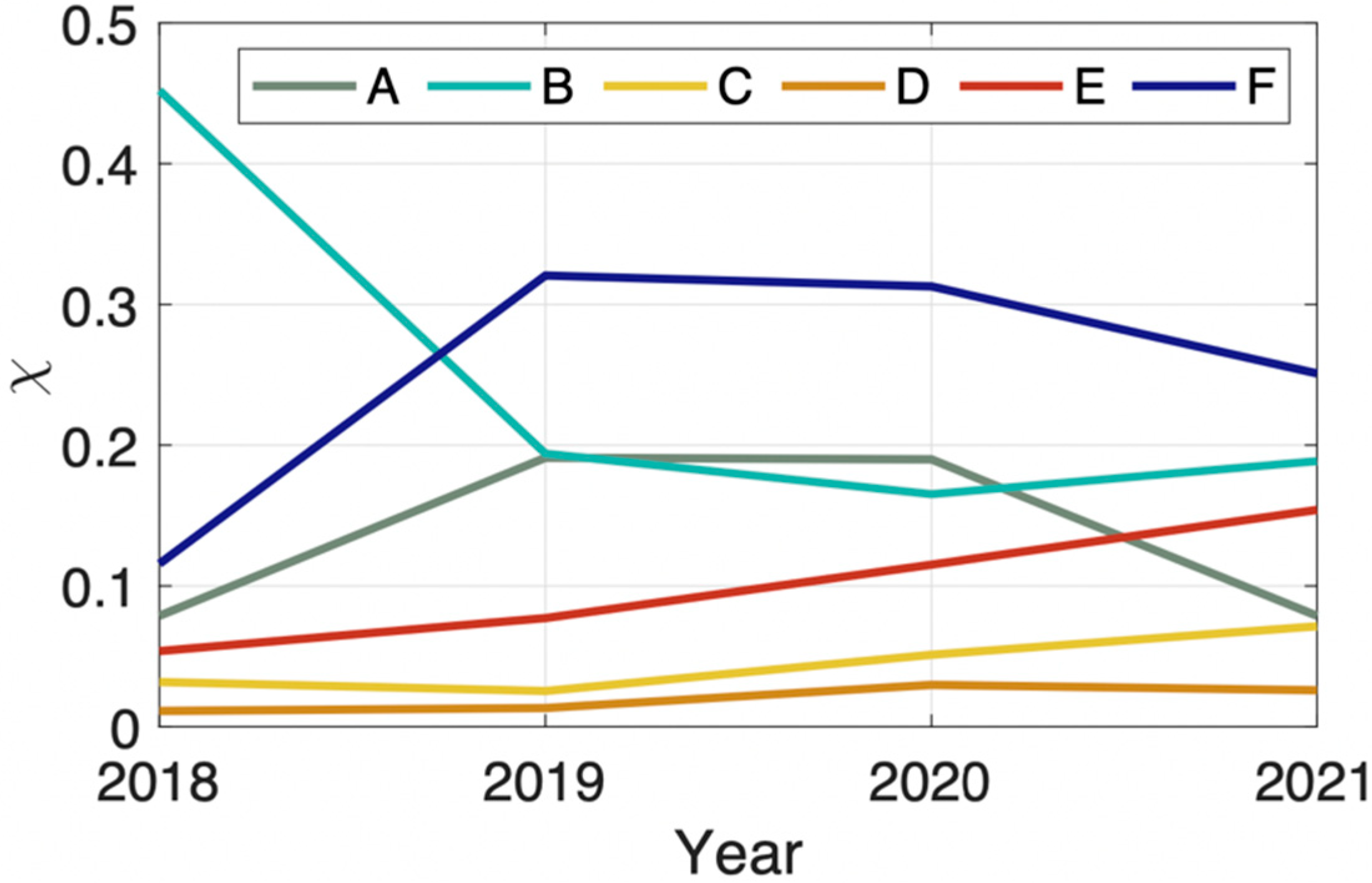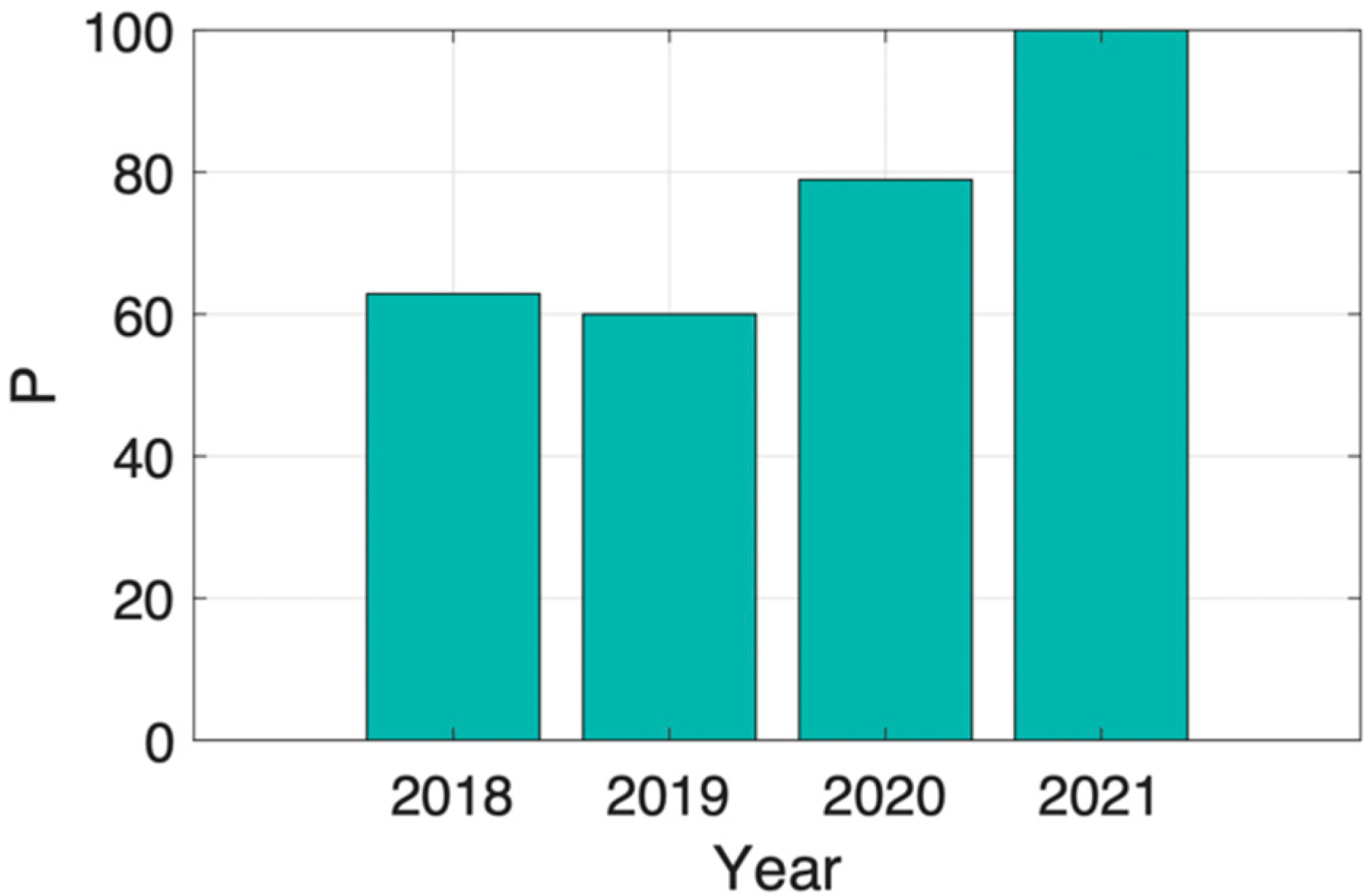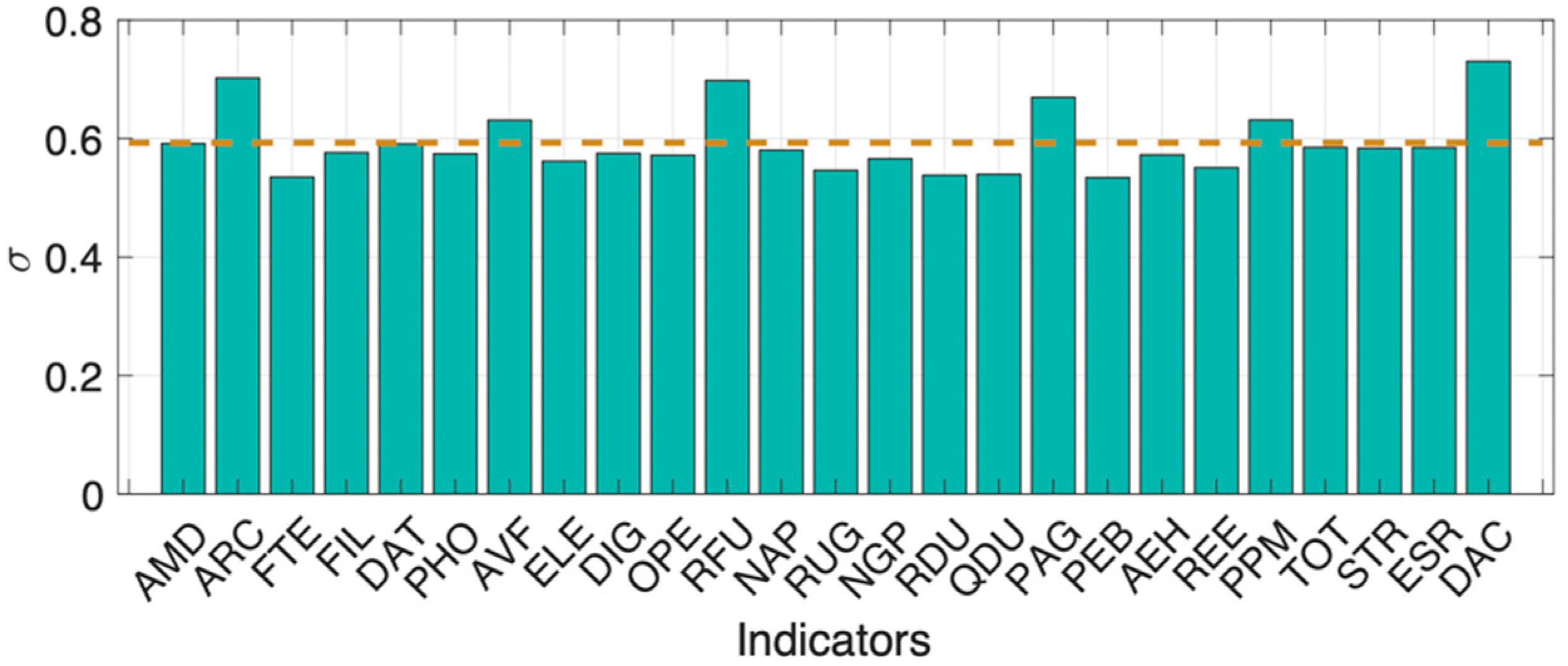Modeling and Analysis of the Sustainable Development of Chinese Archival Work in the Past Four Years
Abstract
1. Introduction
2. Data and Methods
2.1. Data
2.2. Methods
2.2.1. Data Processing and Weight Decision
2.2.2. Measurement
2.2.3. Evaluation and Explanation
2.2.4. Stability Analysis
3. Results and Discussion
4. Concluding Remarks
- Speed up the construction of digital archives. Digital archives are essential to realizing the continuous accumulation, complete collection, long-term preservation, centralized management, security control, and the effective utilization of human digital memory. Due to the COVID-19 pandemic, the availability of offline archives is reduced, and the importance of digital archives is particularly prominent. Provinces, cities, and regions across the country have made some explorations in the construction of digital archives. They have achieved initial results and gained some successful experience. However, the progress is relatively slow. We suggest that governments at all levels should increase investment, formulate goals and plans, and regard the construction of digital archives as the general blueprint and principle of the archival work.
- Promote the construction of archives resource system deeply. Archive information resources are the foundation of the field. Archives of all levels and types should fully expand the scope of archival resource collection, strengthen the collection of major events and emergencies, and extend storage forms (paper, electronic, photo, film, etc.). At the same time, it is necessary to optimize the collection structure and realize the digital transformation of archival resources.
- Cultivate archival professionals vigorously. Professionals guarantee the steady development of the field. Due to the staff reduction, future practitioners will face more challenges. The government should deepen cooperation with colleges and universities, build archival talent training bases, and speed up the cultivation of archival professionals. Moreover, it is essential to improve the talent evaluation system.
- Improve file utilization service capabilities. The use of archives is the way to realize the value of archival work. Archives at all levels should continue to optimize the utilization environment, simplify the utilization procedures, and meet public needs. It is necessary to develop Internet/mobile terminal query and utilization services, especially in this period when COVID-19 is sweeping the world.
Author Contributions
Funding
Data Availability Statement
Acknowledgments
Conflicts of Interest
References
- Fowles, C.; University of South Dakota. Glossary of Library and Internet Terms. 2000. Available online: https://web.archive.org/web/20090310132820/http://www.usd.edu/library/instruction/glossary.shtml#a (accessed on 11 September 2022).
- Jo, E.S.; Gebru, T. Lessons from archives: Strategies for collecting sociocultural data in machine learning. In Proceedings of the 2020 Conference on Fairness, Accountability, and Transparency, Barcelona, Spain, 27–30 January 2020; pp. 306–316. [Google Scholar]
- Schwartz, J.M.; Cook, T. Archives, records, and power: The making of modern memory. Arch. Sci. 2002, 2, 1–19. [Google Scholar] [CrossRef]
- Cook, T. What is past is prologue: A history of archival ideas since 1898, and the future paradigm shift. Archivaria 1997, 43, 17–63. [Google Scholar]
- Bingham, A. The digitization of newspaper archives: Opportunities and challenges for historians. Twent. Century Br. Hist. 2010, 21, 225–231. [Google Scholar] [CrossRef]
- Jimerson, R. Archives for all: Professional responsibility and social justice. Am. Arch. 2007, 70, 252–281. [Google Scholar] [CrossRef]
- Flinn, A. Community histories, community archives: Some opportunities and challenges. J. Soc. Arch. 2007, 28, 151–176. [Google Scholar] [CrossRef]
- Netshakhuma, N.S. Analysis of Archives Infrastructure in South Africa: Case of Mpumalanga Provincial Archives. Global Knowledge 2019, Memory and Communication. Available online: https://www.emerald.com/insight/content/doi/10.1108/GKMC-03-2019-0043/full/html (accessed on 11 September 2022).
- Lv, Z.; Shi, H. The exploring on university archives management system based on information system. J. Phys. Conf. Ser. 2020, 1550, 032017. [Google Scholar] [CrossRef]
- Oyelude, A.A. Libraries, librarians, archives, museums and the COVID-19 pandemic. Libr. Hi Tech News 2020, 37, 5–6. [Google Scholar] [CrossRef]
- Lian, Z.; Oliver, G. Sustainability of independent community archives in China: A case study. Arch. Sci. 2018, 18, 313–332. [Google Scholar] [CrossRef]
- Zeng, S.; Fang, Z.; He, Y.; Huang, L. An Integrated Entropy-COPRAS Framework for Ningbo-Zhoushan Port Logistics Development from the Perspective of Dual Circulation. Systems 2022, 10, 131. [Google Scholar] [CrossRef]
- Jiao, L.; Wu, F.; Zhu, Y.; Luo, Q.; Luo, F.; Zhang, Y. Research on the Coupling Coordination Relationship between Urban Rail Transit System and Sustainable Urban Development. Systems 2022, 10, 110. [Google Scholar] [CrossRef]
- Lu, H.; Du, D.; Qin, X. Assessing the Dual Innovation Capability of National Innovation System: Empirical Evidence from 65 Countries. Systems 2022, 10, 23. [Google Scholar] [CrossRef]
- Zhang, Y.; Liu, Y.; Min, X.; Jiang, Q.; Su, W. Selection of Landfill Cover Materials Based on Data Envelopment Analysis (DEA)—A Case Study on Four Typical Covering Materials. Sustainability 2022, 14, 10888. [Google Scholar] [CrossRef]
- Guo, S.; Zheng, X.; Heath, T. Research on the Design of Community Museums Based on the Fuzzy Comprehensive Evaluation Method. Sustainability 2022, 14, 10802. [Google Scholar] [CrossRef]
- Li, H.; Chen, Z. A Comprehensive Evaluation Framework to Assess the Sustainable Development of Schools within a University: Application to a Chinese University. Sustainability 2022, 14, 10671. [Google Scholar] [CrossRef]
- Lai, Y.J.; Liu, T.Y.; Hwang, C.L. Topsis for MODM. Eur. J. Oper. Res. 1994, 76, 486–500. [Google Scholar] [CrossRef]
- Wang, Y.; Xi, C.; Zhang, S.; Zhang, W.; Yu, D. Combined approach for government E-tendering using GA and TOPSIS with intuitionistic fuzzy information. PLoS ONE 2015, 10, e0130767. [Google Scholar] [CrossRef]
- Wei, G.W. GRA method for multiple attribute decision making with incomplete weight information in intuitionistic fuzzy setting. Knowl.-Based Syst. 2010, 23, 243–247. [Google Scholar] [CrossRef]
- Liu, S.; Yang, Y.; Cao, Y.; Xie, N. A summary on the research of GRA models. Grey Syst. Theory Appl. 2013, 3, 7–15. [Google Scholar] [CrossRef]
- Al-Harbi, K.M.A.S. Application of the AHP in project management. Int. J. Proj. Manag. 2001, 19, 19–27. [Google Scholar] [CrossRef]
- Tan, R.R.; Aviso, K.B.; Huelgas, A.P.; Promentilla, M.A.B. Fuzzy AHP approach to selection problems in process engineering involving quantitative and qualitative aspects. Process Saf. Environ. Prot. 2014, 92, 467–475. [Google Scholar] [CrossRef]
- Saaty, T.L.; De Paola, P. Rethinking design and urban planning for the cities of the future. Buildings 2017, 7, 76. [Google Scholar] [CrossRef]
- Yadav, S.S.K.; Gupta, H.; Bandyopadhayay, A. Selection of a sustainability awareness project in an academic institution using the Analytic Hierarchy Process (AHP). Int. J. Technol. Manag. Sustain. Dev. 2015, 14, 205–225. [Google Scholar] [CrossRef]
- Saaty, T.L.; Özdemir, M.S.; Shang, J.S. The rationality of punishment—Measuring the severity of crimes: An AHP-based orders-of-magnitude approach. Int. J. Inf. Technol. Decis. Mak. 2015, 14, 5–16. [Google Scholar] [CrossRef]
- Akarte, M.M.; Ravi, B. Casting product–process–producer compatibility evaluation and improvement. Int. J. Prod. Res. 2007, 45, 4917–4936. [Google Scholar] [CrossRef]
- van de Kaa, G.; Van Heck, E.; de Vries, H.J.; van den Ende, J.; Rezaei, J. Supporting decision making in technology standards battles based on a fuzzy analytic hierarchy process. IEEE Trans. Eng. Manag. 2013, 61, 336–348. [Google Scholar] [CrossRef]
- Franek, J.; Kresta, A. Judgment scales and consistency measure in AHP. Procedia Econ. Financ. 2014, 12, 164–173. [Google Scholar] [CrossRef]




| Primary Index | Indicators | Abbreviation | Weight (%) |
|---|---|---|---|
| Number of institutions (10%) | Archive management department | AMD | 4.60 |
| Archives | ARC | 5.40 | |
| Full-time employees (15%) | Full-time employees | FTE | 15.00 |
| Collection (25%) | Files | FIL | 5.13 |
| Data | DAT | 2.56 | |
| Photos | PHO | 3.85 | |
| Audio tapes, video tapes, and film files | AVF | 3.85 | |
| Electronic archives | ELE | 5.13 | |
| Digital copy of library archives | DIG | 4.49 | |
| Opening and utilization of archives (offline) (25%) | Open archives | OPE | 1.67 |
| Reception file users | RFU | 3.33 | |
| Number of archives provided | NAP | 3.33 | |
| Reception users of government public information/current documents | RUG | 2.67 | |
| Number of government public information/current documents provided | NGP | 2.67 | |
| Reception data user | RDU | 1.00 | |
| Quantity of data used | QDU | 1.00 | |
| Number of public access places for government information in archives | PAG | 1.33 | |
| Number of patriotism education base in archives | PEB | 2.00 | |
| Number of archival exhibitions held | AEH | 2.00 | |
| Reception of exhibition | REE | 2.00 | |
| Publicly published materials | PPM | 2.00 | |
| Floor space of archives (10%) | Total | TOT | 2.80 |
| Storage Room | STR | 3.20 | |
| External service room | ESR | 4.00 | |
| Digital archives certified by the competent archives department at or above the provincial level (15%) | Digital archives certified by the competent archives department at or above the provincial level | DAC | 15.00 |
Publisher’s Note: MDPI stays neutral with regard to jurisdictional claims in published maps and institutional affiliations. |
© 2022 by the authors. Licensee MDPI, Basel, Switzerland. This article is an open access article distributed under the terms and conditions of the Creative Commons Attribution (CC BY) license (https://creativecommons.org/licenses/by/4.0/).
Share and Cite
Li, H.; Chen, Z. Modeling and Analysis of the Sustainable Development of Chinese Archival Work in the Past Four Years. Appl. Sci. 2022, 12, 11114. https://doi.org/10.3390/app122111114
Li H, Chen Z. Modeling and Analysis of the Sustainable Development of Chinese Archival Work in the Past Four Years. Applied Sciences. 2022; 12(21):11114. https://doi.org/10.3390/app122111114
Chicago/Turabian StyleLi, Hong, and Zilin Chen. 2022. "Modeling and Analysis of the Sustainable Development of Chinese Archival Work in the Past Four Years" Applied Sciences 12, no. 21: 11114. https://doi.org/10.3390/app122111114
APA StyleLi, H., & Chen, Z. (2022). Modeling and Analysis of the Sustainable Development of Chinese Archival Work in the Past Four Years. Applied Sciences, 12(21), 11114. https://doi.org/10.3390/app122111114






